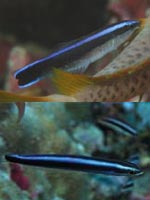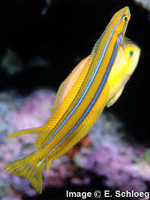
Nature is rife with charlatans. Hundreds of animals have evolved to look like other species in order to fool predators into thinking they're more of a threat, or to sneak up on unsuspecting prey. In the Indo-Pacific lives a fish that does both and has the rare ability to switch between different disguises - the bluestriped fangblenny.
Common though it is, mimicry is usually restrictive and most fakers are stuck with one disguise. Until a few years ago, the only known animal that could switch between different acts was the amazing mimic octopus, which contorts its flexible body to look like seasnakes, lionfish, flounders and other poisonous underwater denizens.
In 2005, Isabelle Cote and Karen Cheney from the University of Queensland discovered that a small reef fish called the bluestriped fangblenny (Plagiotremus rhinorhynchos) is also a dynamic mimic.
Its model is the bluestreak cleaner wrasse Labroides dimidiatus, an industrious species that provides a cleaning service for other reef visitors by picking off parasites and mucus from hard-to-reach places. The fangblenny's intentions are less welcome. Its resemblance to the helpful wrasse allows it to get close enough to mount quick attacks on larger fish, biting off scales and skin (see image below for why it got it's name).
 Cote and Cheney found that fangblennies have two guises. In one, it has a black body and an electric blue stripe that mimics the wrasse, but in the other, it's body is a very different brown, olive or orange with white or light-blue/green stripes. The fish can change from one to the other at will, and uses the non-mimicking colours to blend in with shoals of other fish.
Cote and Cheney found that fangblennies have two guises. In one, it has a black body and an electric blue stripe that mimics the wrasse, but in the other, it's body is a very different brown, olive or orange with white or light-blue/green stripes. The fish can change from one to the other at will, and uses the non-mimicking colours to blend in with shoals of other fish.
Now, Cheney has provided further evidence for the opportunistic colour changes of this con artist. She captured 34 fangblennies of various colours and after 60 minutes alone, all the mimics had switched to non-mimic colours - it seems that there's no point putting on a disguise if there's no one around to see it.
When she added another fish, nothing happened unless it was a juvenile bluestreak cleaner wrasse. At that point, a third of the fangblennies swapped back to their black-and-blue coats. Cheney noticed that only the smaller individuals changed colours. She believes that as fangblennies grow larger, the rewards of looking like the smaller wrasse are reduced, so they don't bother.
Her field experiments support this idea. On several swims, she noticed that the proportion of mimic to non-mimic fangblennies in the water was proportional to the number of juvenile cleaner wrasse around.
A disguise may look right to us, but our colour vision is very different to that of most animals, including those whose reaction actually matters. To get a more objective view of the fangblenny's disguise, Cheney analysed the light reflecting off its scales when it went through its different colour phases. Sure enough, its black-and-blue form reflected light in almost exactly the same way as a real cleaner wrasse would.
The fangblenny's other colours also proved to be a match to other reef fish. The olive forms were most likely to be found among blue-green chromis, the brown forms mostly swam with the brown and white-coloured two-tone wrasse and the orange forms associated with orange Lyretail Anthias. In each of these cases, the pattern of light reflected off the fangblenny's coat matched that of its preferred companion.
The bluestripe fangblenny's many faces gives it great versatility. By matching the colours of a variety of different fish, it greatly expands the area of reef where it can safely hide from both predators and potential victims. Unlike the mimic octopus, it makes no effort to change its body shape and some of its models, like the chromis, are very different. But in a shoal, that hardly matters. A superficial resemblance to the surrounding throng may be advantage enough.
Reference: Cheney, Grutter & Marshall. 2007. Facultative mimicry: cues for colour change and colour accuracy in a coral reef fish. Proc Roy Soc B doi.10.1098/rspb.2007.0966
Images by K.Cheney and E.Schloeg.
More on mimicry:
- Spider mimics ant to eat spiders and avoid being eaten by spiders
- Moths mimic each others' sounds to fool hungry bats
- Butterflies scrounge off ants by mimicking the music of queens
- Orchid lures in pollinating wasps with promise of fresh meat
- Cuckoos mimic hawks to fool small birds
- Vaccinia virus tricks its way into hosts by mimicking dead cells




The blenny/wrasse interaction is shown very well on the PBS NOVA episode "Animal Imposters" from 1982. This is a great video covering all sorts of biological mimicry which I show to my biology students.